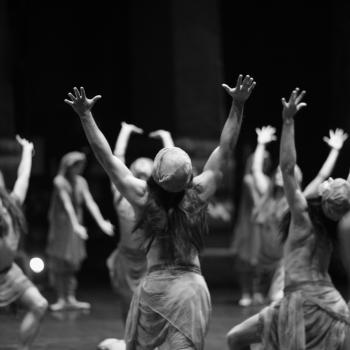Connor Wood
One of the great things about studying religion is that it’s a huge evolutionary puzzle. If you’re the type who likes puzzles, you could sign up right now for a career in the evolutionary study of religion and probably never be bored again for the rest of your life. The riddles abound: Why have we (apparently) evolved the capacity for profound religious experiences? Is there an evolutionary function for spirits, gods, or religious rituals? Many researchers argue that religion is a functionless byproduct of other evolutionary developments, while others claim that religion is a useful adaptation that helps human groups survive. Funnily enough, one recent paper sheds light on this debate despite not mentioning religion at all.
The paper, entitled “Limits of Inclusive Fitness,” appeared in the Proceedings of the National Academy of Sciences (PNAS) earlier this fall. Its authors – Ben Allen, Martin Nowak, and E.O. Wilson – are evolutionary scientists at Emmanuel College and Harvard. (Full disclosure: Ben is also a friend of mine.) The paper is a mathematical critique of one of the most influential theoretical contributions to 20th-century evolutionary biology: inclusive fitness, or the claim that an organisms’ total “fitness” is an additive combination of its own success and its close relatives’ success at the game of life.
A quick background: Inclusive fitness theory was developed by a number of evolutionary scientists in the mid-20th century to answer the question of how costly altruism could possibly evolve in a Darwinian world such as our own. How could Darwinian theory explain the fact that animals (and humans) often apparently sacrifice their own genetic well-being to benefit their peers? Shouldn’t evolutionary pressures force everyone to look out for their own interests first? The most common example of this conundrum is in the colonies of eusocial insects such as ants, where sterile workers sacrifice their entire reproductive careers to serve the queen and her offspring. But costly altruism also famously occurs in humans, who often sacrifice their lives for one another or otherwise put the needs of their group above their own genetic interests.
The person most often connected with inclusive fitness is W.D. Hamilton (1936-2000), a British evolutionary biologist. In 1964, Hamilton published an early version of a formula that attempted to explain such apparently confusing social phenomena. Known as Hamilton’s Rule, the formula models altruistic sacrifice as actually beneficial to the organism doing the sacrificing – as long as the beneficiary is a fairly close relative. The expression goes like this:
rB > C
Let me sum up: The “r” means the “coefficient of relatedness,” or the degree to which two individuals are related to each other. You and a clone of yourself would have an “r” of 1, since your genes would be fully identical. But your coefficient of relatedness with a non-twin sibling is roughly .5, because about half of any genes in your genome are from the same parent. The coefficient of relatedness drops off fast; your “r” with a first cousin is only .125, for example.
The “B” refers to benefit – specifically, the benefit to the relative who’s receiving an altruistic boon. For example, let’s say that you rush into a fiery house to save your sibling, and this boosts your sibling’s chances of having children from zero – dead people don’t have children – to, say, 60%. This means that the “B” value would be pretty high!
In contrast, the “C” refers to the “cost” to the organism who gives the help. Let’s say that you get burned while saving your sibling. This reduces your probable lifetime fitness, because it’s harder to get a mate and good jobs with a scarred face. The “C” in Hamilton’s Rule quantifies this damage to your lifetime fitness.
Hamilton postulated that the only time organisms could evolve costly, sacrificial behavior would be when the partners are closely related enough, and the increase in beneficiaries’ fitness is great enough, to override the costs of the sacrifice to the benefactors. For example, Hamilton’s Rule predicts that ants will be closely related enough to their queen that their giving up reproduction will actually pay off genetically in the long term – since the little ant eggs they’re raising carry enough of their own genes to make up for their sacrifice.
Hamilton’s Rule and inclusive fitness theory were the uncontested champions in the struggle to explain costly altruism in biology for nearly a half-century. But in the past decade, a number of scientists have been challenging inclusive fitness, often – but not always – on mathematical grounds. This is where the PNAS paper comes in.
To (over)simplify things, Ben, Nowak, and Wilson argue that inclusive fitness theory depends too heavily on linear regression models to explain how genetic relatedness affects evolution. Regression analysis is a statistical technique that identifies the different factors influencing an observed outcome. For example, let’s say that students from the west side of your town are 30% more likely to attend college than kids from the east side. A regression analysis finds that several different factors combine to predict this difference: for example, the west side is wealthier than the east side; there are more native English speakers on the west side; and college recruiters visit west side high schools more often than east side schools. Together, these factors add up to explain the higher college attendance rate on the west side.
Similarly, evolutionary biologists have long been in the habit of using linear regression models to separate organisms’ genetic fitness into components. For example, 50% of an organism’s total genetic fitness might be due to the offspring it raises itself, and 25% due to the offspring its siblings help it raise, and 12% to the offspring its cousins help it raise. The authors of the PNAS paper argue, roughly, that this is an unhelpful way of modeling genetic fitness. To quote Ben’s blog post on the paper:
At this point you may be asking “Wait, does it really make sense to divide offspring into those produced on one’s own versus those produced by help from others?” This is exactly the problem! Aside from the obvious point that no one reproduces without help in sexual species, nature is full of synergistic and nonlinear interactions, so that making clean divisions like this is impossible in most situations. Thus the idea of inclusive fitness theory only works in simplified toy models of reality.
So, Ben and the other authors claim, the inclusive fitness model is just not close enough to reality to be useful. The second major problem with the mathematics behind inclusive fitness theory, they argue, is that such mathematics can – and does! – lead researchers to make false attributions of causality when only correlations are evident. The paper offers some elucidating hypothetical examples, including the “hanger-on:” an organism that has a gene which drives it to find high-fitness individuals and hang out with them. The hanger-on doesn’t get any extra fitness benefit from palling around with its high-fitness peers, but an observer looking at the long-term population data would always find that individuals with the “hanger-on” gene were found closely associated with individuals who had lots of offspring. An inclusive fitness analysis would conclude that the “hanger-on” gene was actually a helping gene – one that inspired individuals to sacrifice their own well-being in order to help nearby partners raise their own offspring. Of course, this would be exactly the wrong explanation: the hanger-on doesn’t cause the high-fitness partner to have offspring. The high-fitness parter causes the hanger-on to glom on.
These and related arguments lead the authors of the PNAS paper to conclude that the right way to investigate the evolution of altruism is using old-fashioned Darwinian techniques based on natural selection models. Inclusive fitness, the authors argue, requires too many assumptions to work, doesn’t make good predictions or offer explanations, and is too general to be applied to any real circumstances.
Now, what does all of this have to do with religion? Surprisingly, a lot. The main opponents of inclusive fitness theory have tended to be proponents of various sorts of group selection – a broad term that generally refers to the ability of Darwinian processes to operate not only at the level of the gene, but also at the collective. For example, let’s say two tribes occupy the same valley, but one of them has a preponderance of genes that encourage costly cooperation within the group. Over generations, the tribe whose members cooperate better with one another slowly take over and push out the other tribe. The costly-cooperation gene hurts the individuals who carry it within their own groups (since they’re always sacrificing their own well-being to help their fellows), but helps the group as a whole (since the group functions better if it has lots of members who are willing to sacrifice for one another). The result? Over time, the costly-cooperation gene comes to dominate the valley, even though it imposes fitness costs on the individuals who have it.
Several writers, including Martin Nowak and David Sloan Wilson, have suggested that group selection might be a better explanation for the evolution of morality than inclusive fitness. This might seem plausible to an educated outsider, but there’s a problem: many of these writers also use group selection to argue for the evolutionary utility of religion. In his 2002 book Darwin’s Cathedral, for example, D.S. Wilson argued that religion overwhelmingly helps groups survive, and that religious practices and beliefs – as well as the costly altruism they encourage – have evolved by group selection.
On the other side of the equation, the proponents of inclusive fitness theory have tended to be among the most vociferous critics of religion writing today. Steven Pinker, Richard Dawkins, Jerry Coyne, and Daniel Dennett are all on record as being strongly pro-inclusive fitness and very much opposed to group selection theories. There are both personal and professional commitments on the line here; to pick an example, Hamilton’s memorial service in 2000 was organized by Richard Dawkins.
Now, I’m not claiming that Richard Dawkins’s personal friendship with and admiration for W.D. Hamilton means that Dawkins’s support for inclusive fitness is automatically suspect. I happen to personally side with the religious adaptationists – those who argue that religious phenomena are dedicated adaptations – but I’m not convinced that group selection is the way to get there. And there is evidence that inclusive fitness theory works very well in some situations; for example, in explaining why red squirrels adopt some orphaned babies but not others (hint: they don’t adopt babies whose “r” coefficient doesn’t meet the predictions of Hamilton’s Rule).
The authors of the PNAS paper, including my buddy Ben, wouldn’t contest the squirrel finding; they freely admit that sometimes inclusive fitness theory works. Instead, they argue that it’s simply not a universally generalizable rule. They have some very good points, and I think they’re probably right. But what I’m most interested in is how the debates around group selection illustrate how scientific and ideological commitments entwine and influence one another, no matter what the textbooks say. It is not coincidence that the ranks of the anti-group selectionists are a who’s who of the New Atheists. It’s also not coincidence that the group selection advocates tend to argue for religion’s adaptive value.
And finally, it’s not a failure of science that researchers’ ideological and theoretical commitments are sometimes aligned; people have to get their convictions from somewhere. If Daniel Dennett, say, believes that group selection is bunk because he’s afraid that group selection will prove that religion is adaptive rather than a worthless – or harmful! – byproduct, I think that’s great. Research and debate will eventually prove whether he’s right or wrong, regardless of where his commitments come from. This is one of science’s most admirable, and valuable, traits: hypotheses and predictions can come from anywhere, and testing and observation will eventually separate the wheat from the chaff. Ben’s paper in PNAS is just one more fine example of how this winnowing process works.












